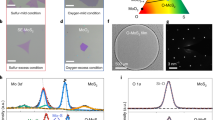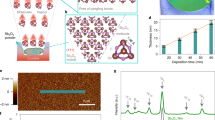Abstract
Two-dimensional molybdenum disulfide (MoS2) is a potential alternative channel material to silicon for future scaled transistors. Scaling down the gate dielectric and maintaining a high-quality interface is challenging with such materials, because the atomic thickness of MoS2 makes it sensitive to defects common in amorphous gate oxides such as hafnium oxide (HfOx). Here we show that a van der Waals gap of 5.3 Å can be formed between HfOx and MoS2 via the ozone treatment of a hafnium disulfide (HfS2)/MoS2 stack. The ozone treatment converts the HfS2 flake into a HfOx dielectric, and excess oxygen accumulation at the interface widens the van der Waals gap. Experimental results and density functional theory calculations show that the increased gap decouples the interaction between the HfOx dielectric and MoS2 channel, allowing the intrinsic properties of the MoS2 semiconductor to be preserved. The resulting MoS2 van der Waals-gap-gated transistors exhibit a negligible hysteresis of 10 mV and average subthreshold slope of 63.1 mV dec−1, which is close to the physical Boltzmann limit of 60.0 mV dec−1. We also show that the transistors can be used to construct NOT, OR and AND logic gates.
This is a preview of subscription content, access via your institution
Access options
Access Nature and 54 other Nature Portfolio journals
Get Nature+, our best-value online-access subscription
$29.99 / 30 days
cancel any time
Subscribe to this journal
Receive 12 digital issues and online access to articles
$119.00 per year
only $9.92 per issue
Buy this article
- Purchase on Springer Link
- Instant access to full article PDF
Prices may be subject to local taxes which are calculated during checkout





Similar content being viewed by others
Data availability
The data that support the plots within this paper and other findings of this study are available from the corresponding authors on reasonable request.
References
Desai, S. B. et al. MoS2 transistors with 1-nanometer gate lengths. Science 354, 99–102 (2016).
Radisavljevic, B., Radenovic, A., Brivio, J., Giacometti, V. & Kis, A. Single-layer MoS2 transistors. Nat. Nanotechnol. 6, 147–150 (2011).
Li, W. et al. Uniform and ultrathin high-κ gate dielectrics for two-dimensional electronic devices. Nat. Electron. 2, 563–571 (2019).
Illarionov, Y. Y. et al. Ultrathin calcium fluoride insulators for two-dimensional field-effect transistors. Nat. Electron. 2, 230–235 (2019).
Zou, X. et al. Interface engineering for high-performance top-gated MoS2 field-effect transistors. Adv. Mater. 26, 6255–6261 (2014).
Bano, A. & Gaur, N. K. Interfacial coupling effect on electron transport in MoS2/SrTiO3 heterostructure: an ab-initio study. Sci. Rep. 8, 714 (2018).
Liu, X. et al. Bonding and charge transfer by metal adatom adsorption on graphene. Phys. Rev. B 83, 235411 (2011).
Schmidt, H., Giustiniano, F. & Eda, G. Electronic transport properties of transition metal dichalcogenide field-effect devices: surface and interface effects. Chem. Soc. Rev. 44, 7715–7736 (2015).
Illarionov, Y. Y. et al. Reliability of scalable MoS2 FETs with 2 nm crystalline CaF2 insulators. 2D Mater. 6, 045004 (2019).
Dahal, A. et al. Seeding atomic layer deposition of alumina on graphene with yttria. ACS Appl. Mater. Interfaces 7, 2082–2087 (2015).
Das, S. et al. Transistors based on two-dimensional materials for future integrated circuits. Nat. Electron. 4, 786–799 (2021).
Knobloch, T. et al. Improving stability in two-dimensional transistors with amorphous gate oxides by Fermi-level tuning. Nat. Electron. 5, 356–366 (2022).
Tan, Q., Zhang, X., Luo, X., Zhang, J. & Tan, P. Layer-number dependent high-frequency vibration modes in few-layer transition metal dichalcogenides induced by interlayer couplings. J. Semicond. 38, 031006 (2017).
Wang, C. et al. Monolayer atomic crystal molecular superlattices. Nature 555, 231–236 (2018).
Gobre, V. V. & Tkatchenko, A. Scaling laws for van der Waals interactions in nanostructured materials. Nat. Commun. 4, 2341 (2013).
Lu, H., Guo, Y., Li, H. & Robertson, J. Modeling of surface gap state passivation and Fermi level de-pinning in solar cells. Appl. Phys. Lett. 114, 222106 (2019).
Bano, A., Krishna, J., Maitra, T. & Gaur, N. K. CrI3-WTe2: a novel two-dimensional heterostructure as multisensor for BrF3 and COCL2 toxic gases. Sci. Rep. 9, 11194 (2019).
Kozlov, S. M., Viñes, F. & Görling, A. Bonding mechanisms of graphene on metal surfaces. J. Phys. Chem. C 116, 7360–7366 (2012).
Liu, W. et al. Benzene adsorbed on metals: concerted effect of covalency and van der Waals bonding. Phys. Rev. B 86, 245405 (2012).
Huang, J. et al. Chemisorption of NO2 to MoS2 nanostructures and its effects for MoS2 sensors. ChemNanoMat 5, 1123–1130 (2019).
Qi, L., Wang, Y., Shen, L. & Wu, Y. Chemisorption-induced n-doping of MoS2 by oxygen. Appl. Phys. Lett. 108, 063103 (2016).
Wang, J. et al. Transferred metal gate to 2D semiconductors for sub-1 V operation and near ideal subthreshold slope. Sci. Adv. 7, eabf8744 (2021).
Si, M. et al. Steep-slope hysteresis-free negative capacitance MoS2 transistors. Nat. Nanotechnol. 13, 24–28 (2018).
Liu, X. et al. MoS2 negative-capacitance field-effect transistors with subthreshold swing below the physics limit. Adv. Mater. 30, 1800932 (2018).
Yang, Y. et al. Probing nanoscale oxygen ion motion in memristive systems. Nat. Commun. 8, 15173 (2017).
Zafar, S., Jagannathan, H., Edge, L. F. & Gupta, D. Measurement of oxygen diffusion in nanometer scale HfO2 gate dielectric films. Appl. Phys. Lett. 98, 152903 (2011).
Shluger, A. in Handbook of Materials Modeling: Applications: Current and Emerging Materials (eds Andreoni, W. & Yip, S.) 1013–1034 (Springer International Publishing, 2020).
Jech, M., El-Sayed, A.-M., Tyaginov, S., Shluger, A. L. & Grasser, T. Ab initio treatment of silicon-hydrogen bond rupture at Si/SiO2 interfaces. Phys. Rev. B 100, 195302 (2019).
Azcatl, A. et al. HfO2 on UV–O3 exposed transition metal dichalcogenides: interfacial reactions study. 2D Mater. 2, 014004 (2015).
Huang, T.-X. et al. Probing the edge-related properties of atomically thin MoS2 at nanoscale. Nat. Commun. 10, 5544 (2019).
Chen, Y.-T., Zhao, H., Yum, J. H., Wang, Y. & Lee, J. C. Metal-oxide-semiconductor field-effect-transistors on indium phosphide using HfO2 and silicon passivation layer with equivalent oxide thickness of 18 Å. Appl. Phys. Lett. 94, 213505 (2009).
Wang, B. et al. High-κ gate dielectrics for emerging flexible and stretchable electronics. Chem. Rev. 118, 5690–5754 (2018).
Mleczko, M. J. et al. HfSe2 and ZrSe2: two-dimensional semiconductors with native high-κ oxides. Sci. Adv. 3, e1700481 (2017).
Lai, S. et al. HfO2/HfS2 hybrid heterostructure fabricated via controllable chemical conversion of two-dimensional HfS2. Nanoscale 10, 18758–18766 (2018).
Peimyoo, N. et al. Laser-writable high-k dielectric for van der Waals nanoelectronics. Sci. Adv. 5, eaau0906 (2019).
Aktulga, H. M., Fogarty, J. C., Pandit, S. A. & Grama, A. Y. Parallel reactive molecular dynamics: numerical methods and algorithmic techniques. Parallel Comput. 38, 245–259 (2012).
Giannozzi, P. et al. Advanced capabilities for materials modelling with QUANTUM ESPRESSO. J. Phys. Condens. Matter 29, 465901 (2017).
Zheng, X. et al. Spatial defects nanoengineering for bipolar conductivity in MoS2. Nat. Commun. 11, 3463 (2020).
Kim, H. et al. Ultrathin monolithic HfO2 formed by Hf-seeded atomic layer deposition on MoS2: film characteristics and its transistor application. Thin Solid Films 673, 112–118 (2019).
Guo, Y. et al. Charge trapping at the MoS2-SiO2 interface and its effects on the characteristics of MoS2 metal-oxide-semiconductor field effect transistors. Appl. Phys. Lett. 106, 103109 (2015).
Geiger, M. et al. Effect of the degree of the gate-dielectric surface roughness on the performance of bottom-gate organic thin-film transistors. Adv. Mater. Interfaces 7, 1902145 (2020).
Cui, X. et al. Low-temperature ohmic contact to monolayer MoS2 by van der Waals bonded Co/h-BN electrodes. Nano Lett. 17, 4781–4786 (2017).
Cao, Z., Lin, F., Gong, G., Chen, H. & Martin, J. Low Schottky barrier contacts to 2H-MoS2 by Sn electrodes. Appl. Phys. Lett. 116, 022101 (2020).
Liu, X. et al. Enhancing photoresponsivity of self-aligned MoS2 field-effect transistors by piezo-phototronic effect from GaN nanowires. ACS Nano 10, 7451–7457 (2016).
Huang, X. et al. Ultrathin multibridge channel transistor enabled by van der Waals assembly. Adv. Mater. 33, 2102201 (2021).
Chamlagain, B. et al. Thermally oxidized 2D TaS2 as a high-κ gate dielectric for MoS2 field-effect transistors. 2D Mater. 4, 031002 (2017).
Wang, H. et al. Integrated circuits based on bilayer MoS2 transistors. Nano Lett. 12, 4674–4680 (2012).
Zou, X. et al. Dielectric engineering of a boron nitride/hafnium oxide heterostructure for high-performance 2D field effect transistors. Adv. Mater. 28, 2062–2069 (2016).
Kim, S. et al. High-mobility and low-power thin-film transistors based on multilayer MoS2 crystals. Nat. Commun. 3, 1011 (2012).
Lin, J. et al. High-current MoS2 transistors with non-planar gate configuration. Sci. Bull. 66, 777–782 (2021).
Tang, A. et al. Toward low-temperature solid-source synthesis of monolayer MoS2. ACS Appl. Mater. Interfaces 13, 41866–41874 (2021).
Wang, X., Sun, Y. & Liu, K. Chemical and structural stability of 2D layered materials. 2D Mater. 6, 042001 (2019).
Wang, J. et al. High mobility MoS2 transistor with low Schottky barrier contact by using atomic thick h-BN as a tunneling layer. Adv. Mater. 28, 8302–8308 (2016).
Liu, J., Zhou, Y. & Zhu, W. Dielectric-induced interface states in black phosphorus and tungsten diselenide capacitors. Appl. Phys. Lett. 113, 013103 (2018).
Sheng, J., Chen, H., Li, B. & Chang, L. Temperature dependence of the dielectric constant of acrylic dielectric elastomer. Appl. Phys. A 110, 511–515 (2012).
Illarionov, Y. Y. et al. Long-term stability and reliability of black phosphorus field-effect transistors. ACS Nano 10, 9543–9549 (2016).
Liu, X. et al. Transparent megahertz circuits from solution-processed composite thin films. Nanoscale 8, 7978–7983 (2016).
Wan, D. et al. High voltage gain WSe2 complementary compact inverter with buried gate for local doping. IEEE Electron Device Lett. 41, 944–947 (2020).
Acknowledgements
This work was supported by the National Key Research and Development Program of Ministry of Science and Technology (no. 2018YFA0703700), China National Funds for Distinguished Young Scientists (grant 61925403), China National Funds for Outstanding Young Scientists (grant 62122024), the National Natural Science Foundation of China (grant nos. 62274060, 12174094, 51872084 and 51991341) and Natural Science Foundation of Hunan Province (grant nos. 2021JJ20028 and 2020JJ1002), and partly by the Key Research and Development Plan of Hunan Province (grant nos. 2022WK2001 and 2018GK2064).
Author information
Authors and Affiliations
Contributions
P.L. and C.L. contributed equally to this work. L.L. and X.L. conceived and designed the experiments. P.L. fabricated the VGG transistors, measured the electrical performance and prepared the manuscript. C.L. and J.L. designed the schematic and prepared the TEM samples. X.D. completed the current–voltage measurements. W.Q. finished the Raman measurements and MD simulations. W.Z. completed the TEM analysis using the protocols provided by C.M. Y.Lv. provided the DFT analysis. X.Z., Y.Liu., F.S. and J.H. presented the suggestions for improving the quality of this work and revised the manuscript. All the authors examined and commented on the manuscript.
Corresponding authors
Ethics declarations
Competing interests
The authors declare no competing interests.
Peer review
Peer review information
Nature Electronics thanks Theresia Knobloch and the other, anonymous, reviewer(s) for their contribution to the peer review of this work.
Additional information
Publisher’s note Springer Nature remains neutral with regard to jurisdictional claims in published maps and institutional affiliations.
Supplementary information
Supplementary Information
Supplementary Figs. 1–18.
Rights and permissions
Springer Nature or its licensor (e.g. a society or other partner) holds exclusive rights to this article under a publishing agreement with the author(s) or other rightsholder(s); author self-archiving of the accepted manuscript version of this article is solely governed by the terms of such publishing agreement and applicable law.
About this article
Cite this article
Luo, P., Liu, C., Lin, J. et al. Molybdenum disulfide transistors with enlarged van der Waals gaps at their dielectric interface via oxygen accumulation. Nat Electron 5, 849–858 (2022). https://doi.org/10.1038/s41928-022-00877-w
Received:
Accepted:
Published:
Issue Date:
DOI: https://doi.org/10.1038/s41928-022-00877-w
This article is cited by
-
Controllable van der Waals gaps by water adsorption
Nature Nanotechnology (2024)
-
Sub-5 nm bilayer GaSe MOSFETs towards ultrahigh on-state current
Frontiers of Physics (2024)
-
Vertically grown ultrathin Bi2SiO5 as high-κ single-crystalline gate dielectric
Nature Communications (2023)
-
High-sensitive two-dimensional PbI2 photodetector with ultrashort channel
Frontiers of Physics (2023)
-
Recent developments in CVD growth and applications of 2D transition metal dichalcogenides
Frontiers of Physics (2023)



